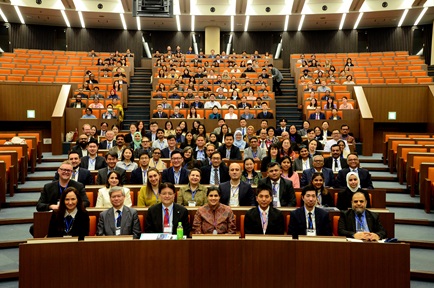On top of voluminous annual reports and financial statements, more companies are presenting their actions in the environmental, social and governance (ESG) space in what's called a sustainability report.
In Singapore, listed companies like Singapore Airlines, Singtel, CapitaLand and the trio of local banks have put out such documents, outlining efforts such as green loans, transitions to renewable energy and tapping novel technology like sustainable aviation fuel.
The latest is Temasek, whose first such report released earlier in July offered the most in-depth look yet at the Singapore state investor’s sustainability-aligned investments.
With their litany of new acronyms, these reports – which can stretch to over a hundred pages – can seem like rocket science at times.
What is a sustainability report?
Put simply, it's where a company discloses and evaluates its environmental impact, social responsibilities and governance practices.
Financial numbers are replaced by figures on emissions footprints, on the back of many firms setting out net-zero targets and ways to cope with climate-related risks and opportunities.
A sustainability report also typically includes how a company intends to deal with issues that range from workplace discrimination and labour standards to product safety.
For example, Singtel has a policy for employees to make confidential reports related to workplace harassment and discrimination. The number of reported cases across Singtel and its Australian unit Optus, and the nature of substantiated cases, are laid out in its sustainability report.
Then there’s corporate governance that includes ethical conduct, board diversity, risk management and more. CapitaLand is among those that disclose internal controls on fraud, bribery and corruption; and actions taken for substantiated cases.
Why are companies issuing such reports?
The pressure comes from multiple sources – regulators, investors and customers – and is only expected to grow, said Professor Lawrence Loh, director of the Centre for Governance and Sustainability at the National University of Singapore’s (NUS) business school.
Companies listed on the Singapore Exchange have actually had to publish sustainability reports since 2017, though they are free to select their own preferred reporting standards.
But from the financial year (FY) of 2025, all listed firms will have to make climate-related disclosures based on standards developed by a global accounting body called the International Sustainability Standards Board (ISSB).
From FY2027, this new requirement will also apply to large non-listed companies – defined as having annual revenues of at least S$1 billion (US$0.74 billion) and total assets of at least S$500 million.
Authorities have said they would review in 2027 whether to extend mandatory climate reporting requirements to smaller non-listed companies.
Why are they more important than we think?
Sustainability reports might not make for good bedtime reading but they shouldn't be ignored, experts said.
That's because traditional financial metrics no longer tell the entire story of a company’s performance and outlook.
Stressing that a sustainability report “must be read together” with a firm’s annual report, Prof Loh said: “They are two sides of the coin, and a sustainability report completes the picture of how investors, customers and regulators can view a company.”
The Securities Investors Association Singapore (SIAS) has noted how extreme climate events have disrupted ecosystems, supply chains and business operations - and such sustainability-related risks must be considered by investors.
“There is research which indicates that companies that are able to manage their financially material ESG risks and opportunities tend to outperform others, thus enhancing shareholder value,” founder-CEO David Gerald wrote in a commentary dated Jun 24.
“Therefore, it is becoming increasingly necessary to consider ESG factors, alongside financial metrics, in order to arrive at a holistic investment profile.”
Meanwhile, having a sustainability report also forces companies to measure and disclose climate data and by which, they can be held accountable for, said Nanyang Technological University’s (NTU) associate professor of accounting Kelvin Law.
What are some key terms to know?
Carbon footprint: The climate change impact from greenhouse gases caused by an item or activity.
While most will immediately think of carbon dioxide (CO2), which is emitted from the burning of fossil fuels, other gases are also important.
For example, methane, which is emitted mainly during landfills and agriculture, is 25 times more potent than carbon dioxide in trapping heat in the atmosphere, said NUS’ Prof Loh.
Even more potent is nitrous oxide whose global warming potential is 300 times more than carbon dioxide.
CO2e: Also known as carbon dioxide equivalent. By using carbon dioxide as a reference gas, this provides a metric to compare the carbon footprint of the various greenhouse gases.
Scope 1 emissions: Direct emissions generated by a company, such as from its manufacturing facilities or company vehicles.
Scope 2 emissions: Indirect emissions incurred by a company, for example from the electricity it purchases to heat or cool its buildings.
Scope 3 emissions: Indirect emissions from entities up and down a company’s value chain. These can include purchased goods and services, business travel, commuting, waste disposal and water consumption.
Global Reporting Initiative (GRI): A sustainability disclosure standard-setting body established in 1997. It published a first set of guidelines in 2000, providing the initial global framework for sustainability reporting.
International Sustainability Standards Board (ISSB): A new standard-setting body launched at the United Nations’ COP26 climate summit in late 2021. ISSB has since announced two disclosure standards which came into effect in January.
Singapore is among those transitioning to the ISSB standard.
NUS’ Prof Loh noted that ISSB standards are more focused on the needs of investors, while the GRI is catered for a broader community of stakeholders.
At the moment, the GRI remains the most dominant standard used around the world.
Net zero vs carbon neutral: When a company commits to be net zero, this usually means it plans to reduce greenhouse gas emissions to as close to zero – an ideal state to better combat climate change.
A company can also commit to be carbon neutral, but NTU’s Assoc Prof Law stressed that a distinction must be made between these similar-sounding terms.
Carbon neutrality refers to how carbon dioxide emitted by a company’s activities will be balanced by the same amount being removed from the atmosphere. This can be done by purchasing carbon credits that go towards funding moves such as the planting of trees.
“On paper, it looks like a company has offset its emissions but the slight nuance is that carbon neutrality doesn’t mean that overall emissions have gone down,” NTU’s Assoc Prof Law said.
External assurance: Think of this as auditing, which is already being done for financial statements. There are two forms being done for sustainability reports – limited assurance and reasonable assurance.
Using the example of an independent party arriving at a building said to be built from sustainable materials, Assoc Prof Law said: “For reasonable assurance, additional tests will be carried out, for example, to check the content of the materials.
“For limited assurance, the inspector looks at the materials and notes that procedures were followed. That may be enough.”
That said, limited assurance follows the same evaluation metrics as reasonable assurance. But the former may require fewer or no tests to form a conclusion, he said.
How can you make sense of these reports?
Start by zooming into key sections, SIAS’ Mr Gerald suggested.
These include the board statement, the listing of ESG factors that are material to a business as well as climate-related disclosures and policies.
He added that investors can check for greenwashing – a practice where a business misleads consumers that their products or practices have greater environmental benefits than is the case – by “benchmarking companies’ climate commitments against the latest science, or checking if business processes have been independently certified as sustainable”.
To be sure, such fact-checking might be difficult for the average man on the street, so one way is to look out for the auditor’s comments, said Assoc Prof Law.
Readers should also “be sceptical” and assess if there's a skew towards portraying a glowing report card.
“A good sustainability report should not only be talking about what the company has done well. If you see that, then that might not be a very balanced report,” Assoc Prof Law said.
He cited Swiss food giant Nestle, which in its latest sustainability report touched on how the firm needs to do more to tackle potential child labour in its supply chain.
For Singapore-listed firms, climate-related disclosures and transition plans remain lacking, according to at least one study.
It analysed FY2022 sustainability reports of 535 companies listed on the SGX and found that only 39 per cent integrated climate change into overall risk management.
Less than a quarter analysed the resilience of their strategies against different climate scenarios.
And just 12 per cent of firms produced “reasonably detailed” climate transition plans, noted the study done by SGX Regulation and NUS’ Centre for Governance and Sustainability.
Experts pointed out that another gap to fill is the disclosure of Scope 3 emissions.
This is largely due to companies being more familiar with measuring Scope 1 and 2 emissions. Difficulties in the gathering of relevant data from suppliers across the value chain also compound the issue, they added.
But with Scope 3 emissions accounting for more than 70 per cent of the carbon footprint for most businesses, more can be done, said Assoc Prof Law.
At the end of the day, relevance is key when it comes to preparing a good sustainability report.
NUS' Prof Loh noted that there has been “a lot of inflation in information” and sustainability reports "keep getting longer and longer" in recent years.
"We need to simplify ... There’s a need to go back to the fundamentals: An overall narrative, how does it align with your business, climate data and how you’re handling the entire value chain. That’s all we need.”







